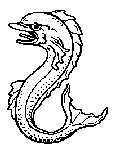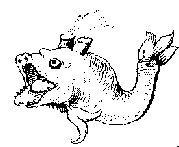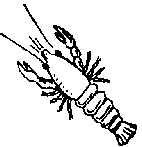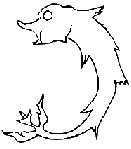Sea Creatures
WARNING: Do not cite this page as a reference. This page is on this wikispace only to make the content "searchable" and easier to find. If you find the information you seek here, go to the original sources as linked below to verify the information and use them for your documentation.
Illustrations:[edit | edit source]
Period:[edit | edit source]
Sea-nettle:[edit | edit source]
| Libri |
| Libri de piscibus marinis: in quibus verae piscium,page 533, by Gulielmi Rondeletii in 1554, sea-nettle or jellyfish |
Modern:[edit | edit source]
Pictorial Dictionary, 3rd edition:[edit | edit source]
| * Fish] |
| * Mermaid; Melusine] |
| * Sea-horse] |
| * Sea-lion] |
| * Sea-monsters] |
| * Sea-nettle] |
| * Sea-serpent] |
Vector Graphics:[edit | edit source]
- Viking Answer Lady - http://www.vikinganswerlady.com/Stars/Heraldry_SVG_Images/index.htm
Sea-horse naiant:[edit | edit source]
Pennsic Traceable Art Project[edit | edit source]
SENA[edit | edit source]
Appendix L:[edit | edit source]
A Partial List of Postures and Orientations This is a list of postures and orientations that can be used to determine whether two charges or groups of charges conflict or whether there is a distinct change for posture/orientation. Animate Charges D. Fish: The postures listed within each group generally conflict, though a distinct change may be given for facing to dexter or to sinister.
- haurient, urinant
- naiant
F. Sea creatures and other Erect-Default Creatures: This category is for sea creatures and other creatures whose default is erect. The postures listed within each group generally conflict.
- erect
A Heraldic Primer:[edit | edit source]
Sea Creatures and their postures - http://heraldry.sca.org/primer/fish.html (defunct, originally by Stephen Gold)
As we have discussed the birds of the air and the beasts of the field, the denizens of the ocean are also seen in armory. They range from the dolphin (a fish very different from Flipper) and the whale through various different fish used primarily for canting. Rounding out the aquatic cavalcade are lobsters, crabs, escallops, octopi [now to be blazoned as polypus/polypi as of March 2012 LoAR in order to use a more period term] and squid [to be blazoned as calamarie or cuttle-fish per the March 2012 LoAR].

|

|

| |
| A dolphin | A lucy (medieval name for pike) | A whale | A lobster |
Just as beasts and birds have certain names for postures, most fish have specific names for postures, as outlined below.
Precedents:[edit | edit source]
Precedents of the SCA College of Arms - http://heraldry.sca.org/laurel/precedents.html
Morsulus Heralds Website - http://www.morsulus.org/ (to search the LoARs and Precedents)
Use the above links to be sure any precedents listed below haven't been superseded by newer precedents.
Definition:[edit | edit source]
December 2020 CL - On Oriental, Part 2[edit | edit source]
In the November 2020 Cover Letter we announced the first in a series of reblazons to remove the term Oriental. We continue this month...
- The single instance of an Oriental sea-dog is just a sea-lion. The emblazon and the note in the O&A make it clear that this monster is based on the stylized stone lions found throughout East Asia, replacing the hindquarters with a fish tail. It is worth taking this moment to remind all that a sea-dog is a quadruped, unlike the sea-wolf or the sea-lion which are fish-tailed.
https://heraldry.sca.org/loar/2020/12/20-12cl.html
January 2017: sea-dog, proper tincture[edit | edit source]
Astrid i Erismarc. Device. Per fess engrailed azure and argent, a monster with the head and torso of a brunette maiden proper, the body of a seadog, and the tail of a wyvern passant vert, winged argent, playing a recorder Or, between three seeblätter counterchanged. "This device is returned for redraw, for violating SENA A2C2 which states "Elements must be drawn to be identifiable." Commenters had trouble identifying the components of the central charge. Despite the blazon, the body is not that of the heraldic sea-dog, which more closely resembles that of a talbot (complete with four feet) than the two-footed, skirted figure drawn here. "Additionally, this device is returned for having a proper-tinctured monster. Precedent says:
"a monster without a heraldically defined proper coloration may not be "brown proper", even if the animals which donated the component parts for the monster may be brown when in nature." [Cynuise ó Cianáin of Bardsea, R-Trimaris, Nov 2002 LoAR] [Reaffirmed LoAR of April 2013]
The same is true for other types of proper besides brown: if the creature doesn't have a defined heraldic coloration when proper, it may not be used in the construction of a new monster. https://heraldry.sca.org/loar/2017/01/17-01lar.html
September 2010 - sea nettle:[edit | edit source]
Luciana Pesce. Name and badge. (Fieldless) A sea-nettle gules. This is the defining instance of a sea-nettle// in Society armory. The sea-nettle is the creature usually termed a "jellyfish" in modern English. It has a round body with dangling, frond-like tentacles. Documentation was supplied from Gulielmi Rondeletii's Libri de piscibus marinis: in quibus verae piscium, published in 1554, and matches the submitted charge. http://heraldry.sca.org/loar/2010/09/10-09lar.html
Registerability:[edit | edit source]
(Restricted, Reserved, SFPP, OOP)
Conflict:[edit | edit source]
March 2020 - From Wreath: Heraldic Whales and Natural Dolphins[edit | edit source]
The Letter of Pends and Discussion included a submission that raised the question between a heraldic whale and a natural dolphin, which existing precedent does not address. A heraldic whale is a monstrous beast-headed fish-like creature not unlike a heraldic dolphin. As used in the SCA, heraldic whales have distinctive though inconsistent features such as tusks and a spout, based upon various cartographic depictions. The whale is a period heraldic charge, found in period heraldic treatises such as de Bara's Blason des Armoiries (1581), though they do not include spouts or tusks. Without the distinctive features, the whale visually similar to a heraldic dolphin and thus no difference is granted between them. Additionally, we have a long tradition of not granting difference between natural and heraldic versions of the same charge. This is true of both dolphins and whales. However, it has also often been ruled that conflict is not necessarily transitive. The tusks, spout, and body proportions, if they were used consistently with no period heraldic example, would have made the charge visually distinct from a natural dolphin. However, due to both the lack of consistency in depicting heraldic whales in SCA heraldry and a period heraldic example which show none of these features, there is no compelling reason to provide a DC between a heraldic whale and a natural dolphin.
In summary:
- A heraldic whale conflicts with a natural whale
- A heraldic whale conflicts with a heraldic dolphin
- A heraldic dolphin conflicts with a natural dolphin
- A heraldic whale conflicts with a heraldic dolphin
http://heraldry.sca.org/loar/2020/03/20-03cl.html#3
March 2017: sea-dog vs seawolf[edit | edit source]
Humfrey Matthew Lovett. Badge. (Fieldless) A sea-dog rampant argent. "This badge does not conflict with the device of Brand the Black: Checky sable and Or, a seawolf erect argent. There is a DC for the difference between fielded and fieldless design and another DC for the difference between a sea-dog, which is a finned canine quadruped, and a sea-wolf, which has a fish tail. It also does not conflict with the badge of Diana ni Charvell: Counter-ermine, a sea-dog rampant maintaining in dexter paw an arrow and in sinister paw a sword argent, with a DC for the field and another for removing the maintained charges. https://heraldry.sca.org/loar/2016/03/16-03lar.html
May 2005 - tincture of mermaid tails:[edit | edit source]
[#45] Elise l'Éstrange. Name and device. Azure, a mermaid proper crined Or maintaining in her dexter hand a shamshir proper and in her sinister hand a gemstone gules, on a chief argent three crescents gules. This device does not conflict with Camilla de la Reynarde la Droitière, Azure, a blonde mermaid proper, tailed argent, maintaining in each hand a garden rose gules, on a chief argent, three foxes passant gules. There is a CD for changing the tincture of half the mermaid and another for substantially changing the type of the tertiaries under RfS X.4.j.ii. Our practice has been to ignore maintained charges when defining a device as simple armory for the purposes of this rule and RfS X.2. http://heraldry.sca.org/loar/2005/05/05-05lar.html
September 1992 - melusine vs mermaid:[edit | edit source]
Simona Zon d'Asolo. ...The device is also too close to Ellis (Papworth 983): Argent, a mermaid proper. There's no difference granted for melusine vs. mermaid.
February 1992 - dog vs seadog[edit | edit source]
Richard von Alaricsberg. Name and device. Quarterly azure and gules, a sea dog passant Or. "Clear of Anubis (and others), Gules, a dog (talbot, hound, etc.) passant Or, with CDs for the field and for the type of primary. While I do not believe that X.2 would apply between a dog and a sea-dog, I do not have a problem with granting a CD, especially given the separate heraldic existence of a sea-dog from any other kind of dog." http://heraldry.sca.org/loar/1992/02/lar.html
Identifiability:[edit | edit source]
September 1992 - "proper" on argent:[edit | edit source]
Simona Zon d'Asolo. The arms have insufficient contrast on the argent field. Human flesh "proper" was sometimes emblazoned as argent in period tomes; and in any case, carnation (pink) cannot be seen against white. (Technically, a melusine proper is considered neutral, and acceptable on argent; in practice, its contrast with an argent field is borderline. But the arms definitely violate Rule VIII.2.b.i.)... September 1992 LoAR
Collected Precedents:'[edit | edit source]
- 2nd Tenure of Elisabeth de Rossignol (April 2011 - August 2011) - Collected Armory Precedents
- 1st Tenure of Elisabeth de Rossignol (May 2005 - July 2008) - see Fish
- The 2nd Tenure of François la Flamme (October 2004 - May 2005) - see Fish
- The Tenure of Shauna of Carrick Point (May 2004 - August 2004) - Collected Armory Precedents
- 1st Tenure of François la Flamme (August 2001 - April 2004) - Collected Armory Precedents
- The Tenure of Elsbeth Anne Roth (June 1999 - July 2001) - Collected Armory Precedents
- The Tenure of Jaelle of Armida (June 1996 - June 1999) - Single HTML Document
- 2nd Tenure of Da'ud ibn Auda (November 1993 - June 1996) -
- The Tenure of Bruce Draconarius of Mistholme (June 1992 - October 1993) - Collected precedents
- 1st Tenure of Da'ud ibn Auda (June 1990 - June 1992) -
- The Tenure of Alisoun MacCoul of Elphane (September 1986 - June 1990) - Collected Precedents
- The Tenure of Baldwin of Erebor (August 1984 - August 1986) - Single HTML Document
- The Tenure of Wilhelm von Schlüssel (August 1979 - August 1984) - Collected Precedents
- The Tenure of Karina of the Far West (December 1975 - June 1979) - Collected Precedents
- The Early Days (June 1971 - June 1975) - Collected Precedents


